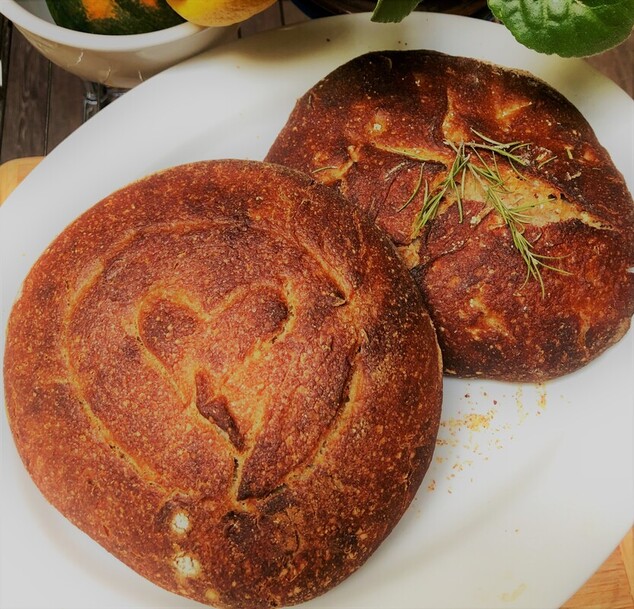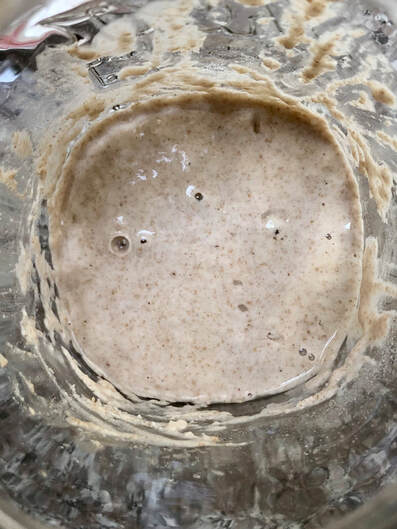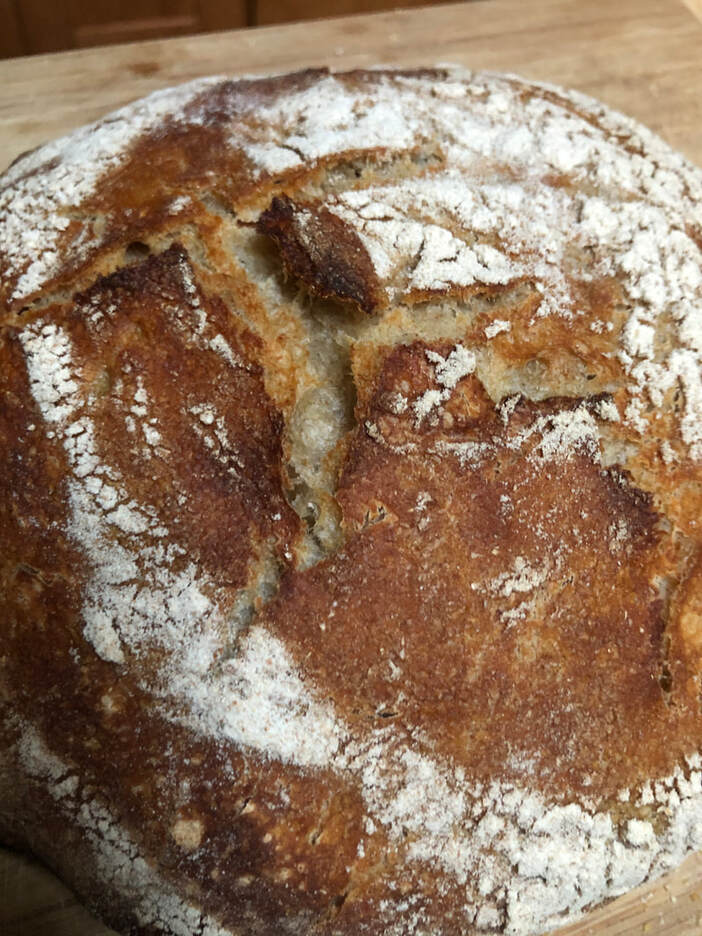|
Not the most beautiful looking homemade loaves of whole grain sourdough but they’re delicious and didn’t require anything but flour, water and salt— no yeast packets necessary! Just naturally leavened, by allowing friendly flora and wild yeasts in the environment to work their fermentation magic to yield a slightly sour work of edible art! Not bad for my first foray into harnessing the power of sourdough starters! The scientist in me is completely enamored by how nature works & loves that the wild ambient yeasts, that are present nearly everywhere in the environment, can be harnessed to leaven bread! When you purchase a jar, packets or cake of yeast, you are getting just one commercially cultivated species (Saccharomyces cerevisiae) and using it to leaven your bread but when you create your own sourdough starter by allowing the wild microflora in the environment to culture or ferment a flour water paste in a cupboard for just under a week, you're ultimately harnessing the power of multiple species of wild organisms to leaven your bread, making for, in my opinion, a more complexly flavorful loaf. Although using just one species may seem easier, more convenient or more predictable, using wild yeast to do the work for you can be a humbling, exciting, and free way to get your bread to rise! Its like going solar instead of paying the power company, or perhaps more closely akin to sun drying all those leftover tomatoes from your garden instead of plugging in the dehydrator and paying for electricity when the sun will do it for you for free! Not to mention that there's no factory production, packaging material, delivery truck shipments or any of that so the carbon footprint is reduced! I know you'll still need power up the oven (unless you have one that's solar-powered) but I'm talking about reducing the footprint, not eliminating it altogether-- for everything we humans do will have an impact but if we can make that impact as low and as beneficial as possible then that's a significant step in a healthy direction! Now, onto a small snippet of the health benefits of allowing wild yeasts to do the work but, first, a little more about the workers who make the magic happen. As mentioned, there are many more species in the flour and in your local environment than just S. cerevisiae so we must also give credit to other some yeast species, like Saccharoymyces exigus, Hanensula anomola, Candida tropicalis, which also contribute to the flavor and, most importantly, the creation of the gases that allow the bread to "rise". But yeasts are not the only stars in sourdough starter; there are various lactic acid producing bacteria (LAB) such as Lactobacillus sanfranciscensis, Lactobacillus plantarum and Lactobacillis brevis that symbiotically live in harmony with the yeast. in the starter. Even still, LAB species aren't the only friendly-flora here so let's give a little credit to the other important species of bacteria, like Leuconostoc, Pediococcus, Enterococcus, Streptococcus, Weissella, and Lactococcus, which help support the process. Like cooperative community members that are all essential, these yeast and bacteria species can best accomplish their objective by working together as a team (which, in this case, is a fabulous loaf of bread!).
Further, it's been noted that the sourdough starter is not stable without the presence of both bacteria and yeast. Bacteria need the yeast to "eat" and digest (through the yeasts' endogenous carb-digesting amylase enzymes) the flour's complex starches into simpler sugars and alcohols (which are food for the bacteria). Then, as the bacteria eat and digest these simpler sugars (like maltose), they, in turn, create beneficial acids that flavor the bread. Yeast need the lactobacillus bacteria species to produce the lactic acid (as a biproduct of their digesting the sugars) as the yeast is more stable in an acidic environment. The relationship is far more complex and does not stop here but the long and short of it is that their symbiotic teamwork is a beautiful thing that results in what we’ve come to expect in a loaf of leavened sourdough! Lastly, allowing these wild species time to feed upon, ferment and help pre-digest some of the flour and water starter (and dough, once the starter and bread ingredients are mixed) lends to the creation of beneficial acids and substances and yields a bread that may be easier for us to digest than a more rapidly-produced loaf that has not had the opportunity to go through this natural process. As for the process of making bread with a starter (which is sometimes also known as a preferment, leaven or levain), the bubbly flour starter that you will create over the course of just under a week is what you will add to more flour, water and salt in order to make the dough. After mixing the bread ingredients with the starter, most recipes will then direct you to fold or stretch the dough at intervals for a few hours before letting it rest and rise at room temperature for a few more hours (or overnight in the refrigerator). Then, it's typically suggested to bake the bread at a fairly high temperature in a covered Dutch oven before removing the lid and baking uncovered for the final duration, in order to form a nice brown crispy crust that encases a deliciously chewy interior. So there is a little bit on the process of how sourdough starter and bread are made along with a bit of the science behind it! One of the recipes I used was a bit simpler than some of the more traditional sourdough recipes but the more traditional recipes resulted in a better tasting and textured bread. That said, I'm going to have to play around and try another few round of rounds :) over the course of a few more weeks before I can confidently share what works best for me and before I may be able to see if I can simplify a more complex recipe into something that feels like a manageable output of effort, energy and time, and results in an end product we can really enjoy sinking our teeth into!
0 Comments
Leave a Reply. |
AuthorUnless otherwise credited, all work is the original content of Amy Pereira Archives
May 2024
Categories
All
|



 RSS Feed
RSS Feed